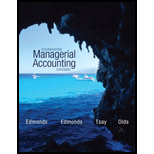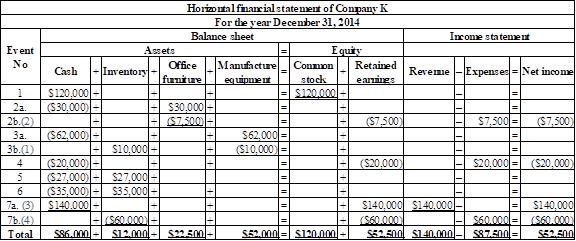
Concept explainers
a.
The total product cost and average cost per unit
a.
Explanation of Solution
Product cost:
It is the cost incurred by the company during the process of manufacturing the product.
Calculation of total product cost for the year 2014 is as follows:

Table (1)
Hence, the total cost of the product for the year 2014 is $72,000.
Calculation average cost per unit for the year 2014 is as follows:
Hence, the average cost per unit for the year 2014 is $6.
Working notes:
Calculation of manufacturing
Hence, the manufacturing overheads is $10,000.
…… (1)
b.
The cost of goods sold that appears in 2014 income statement.
b.
Explanation of Solution
Cost of goods sold
Cost of goods sold is the accumulation of all the direct costs incurred in the process of producing a product. It excludes indirect expenses.
Calculation of total cost of goods sold for the year 2014 is as follows:
Hence, the total cost of goods sold is $60,000.
c.
The cost of ending inventory that appears on 31st December 2014 balance sheet.
c.
Explanation of Solution
Inventory:
It is the term for products ready for sale and raw materials used in making the final product.
Calculation of ending inventory for the year 2014 is as follows:
Hence, the ending inventory for the year 2014 is $12,000.
d.
The total amount of net income for the year 2014.
d.
Explanation of Solution
Financial statement:
The financial statement which reports revenues and expenses from business operations and the result of those operations as net income or net loss for a particular time period is referred to as income statement.
Calculation of net income of the Company K for the year 2014 is as follows:

Table (2)
Hence, the net income of Company K for the year 2014 is $52,500.
Working note:
Calculation of
Hence, the depreciation value of furniture is $7,500.
…… (2)
Calculation of total units sold at the rate of $14 per unit.
The total units sold by the Company K is $140,000.
…… (3)
Calculation of total inventory at the average cost per unit.
The total inventory at the average cost is $60,000.
…… (4)
e.
The total amount of
e.
Explanation of Solution
Financial statement:
The financial statement which reports revenues and expenses from business operations and the result of those operations as net income or net loss for a particular time period is referred to as income statement.
The retained earnings of Company K for the year 2014 is $52,500. (Refer table (2))
f.
The total assets that appears on the balance sheet.
f.
Explanation of Solution
Financial statement:
The financial statement which reports revenues and expenses from business operations and the result of those operations as net income or net loss for a particular time period is referred to as income statement.
Table showing calculation of assets:

Table (3)
Calculation of total assets is as follows:
Hence, the total amount of assets of Company K for the year 2014 is $172,500.
Want to see more full solutions like this?
Chapter 1 Solutions
Fundamental Managerial Accounting Concepts with Access

 AccountingAccountingISBN:9781337272094Author:WARREN, Carl S., Reeve, James M., Duchac, Jonathan E.Publisher:Cengage Learning,
AccountingAccountingISBN:9781337272094Author:WARREN, Carl S., Reeve, James M., Duchac, Jonathan E.Publisher:Cengage Learning, Accounting Information SystemsAccountingISBN:9781337619202Author:Hall, James A.Publisher:Cengage Learning,
Accounting Information SystemsAccountingISBN:9781337619202Author:Hall, James A.Publisher:Cengage Learning, Horngren's Cost Accounting: A Managerial Emphasis...AccountingISBN:9780134475585Author:Srikant M. Datar, Madhav V. RajanPublisher:PEARSON
Horngren's Cost Accounting: A Managerial Emphasis...AccountingISBN:9780134475585Author:Srikant M. Datar, Madhav V. RajanPublisher:PEARSON Intermediate AccountingAccountingISBN:9781259722660Author:J. David Spiceland, Mark W. Nelson, Wayne M ThomasPublisher:McGraw-Hill Education
Intermediate AccountingAccountingISBN:9781259722660Author:J. David Spiceland, Mark W. Nelson, Wayne M ThomasPublisher:McGraw-Hill Education Financial and Managerial AccountingAccountingISBN:9781259726705Author:John J Wild, Ken W. Shaw, Barbara Chiappetta Fundamental Accounting PrinciplesPublisher:McGraw-Hill Education
Financial and Managerial AccountingAccountingISBN:9781259726705Author:John J Wild, Ken W. Shaw, Barbara Chiappetta Fundamental Accounting PrinciplesPublisher:McGraw-Hill Education





